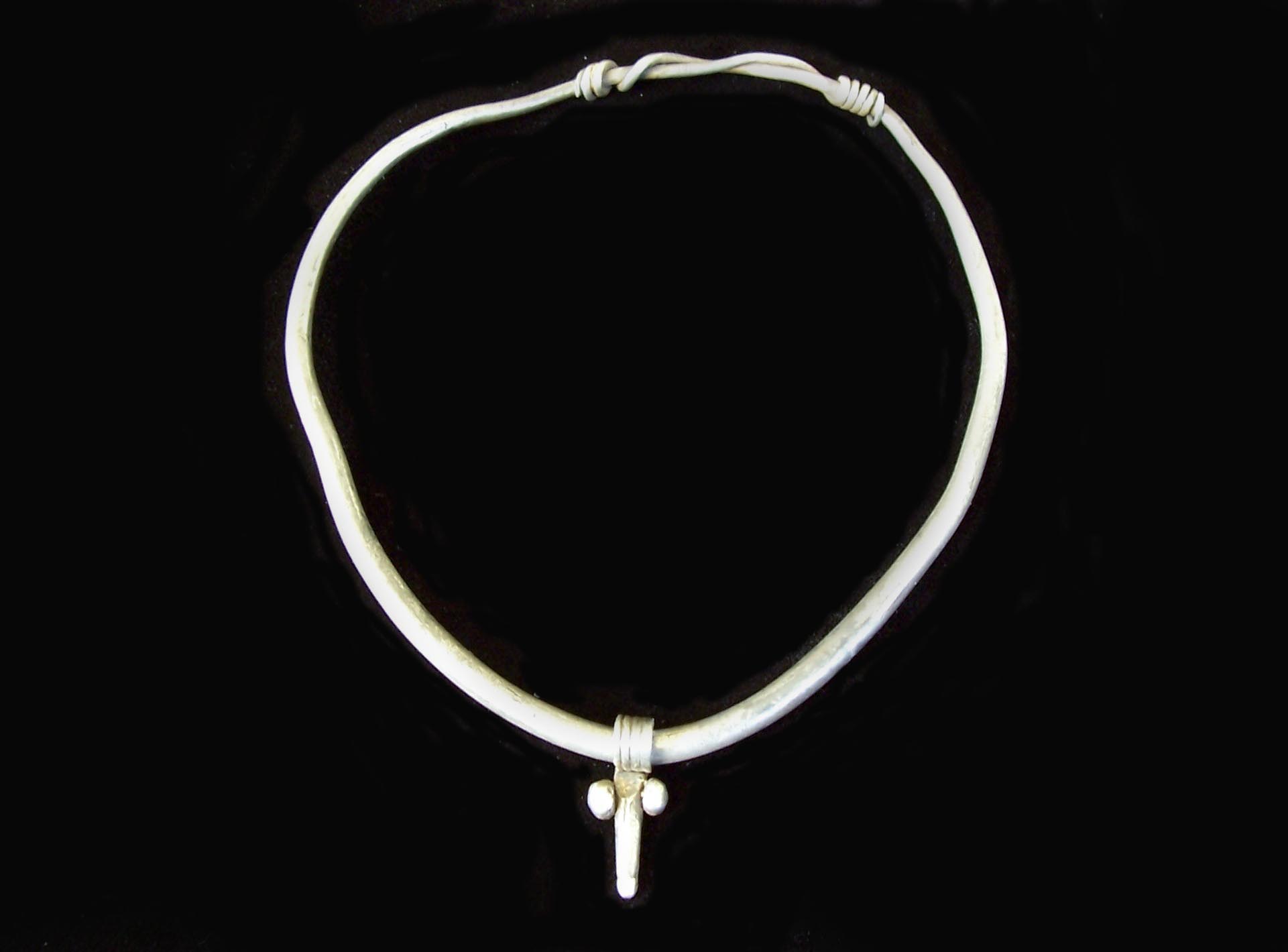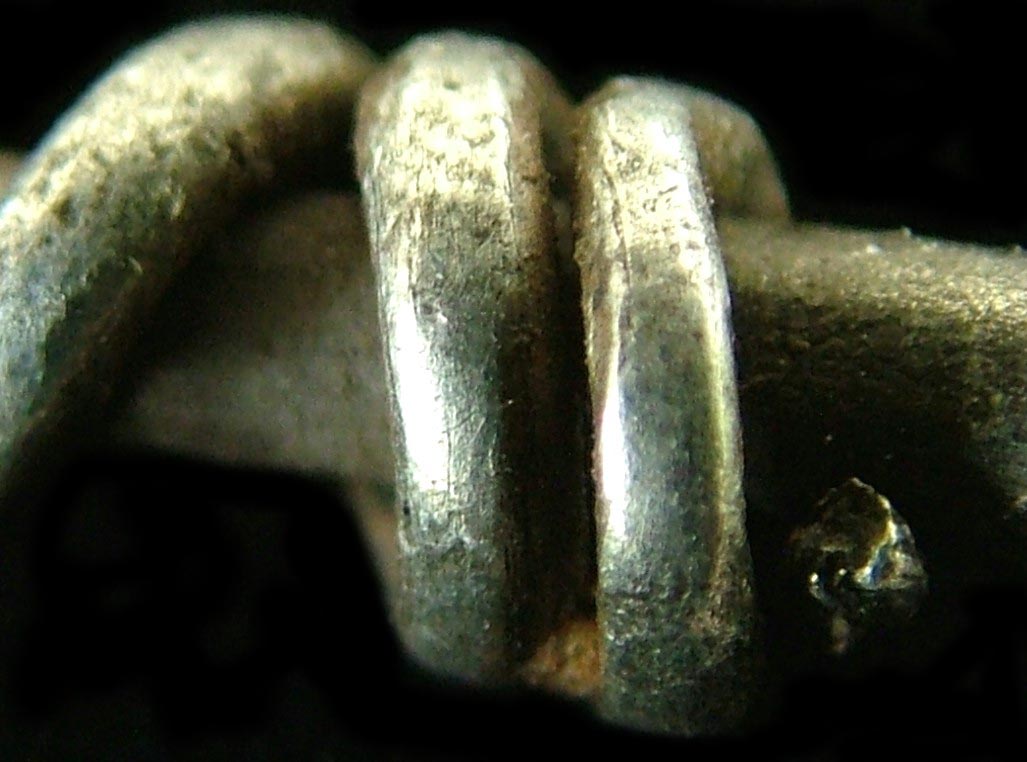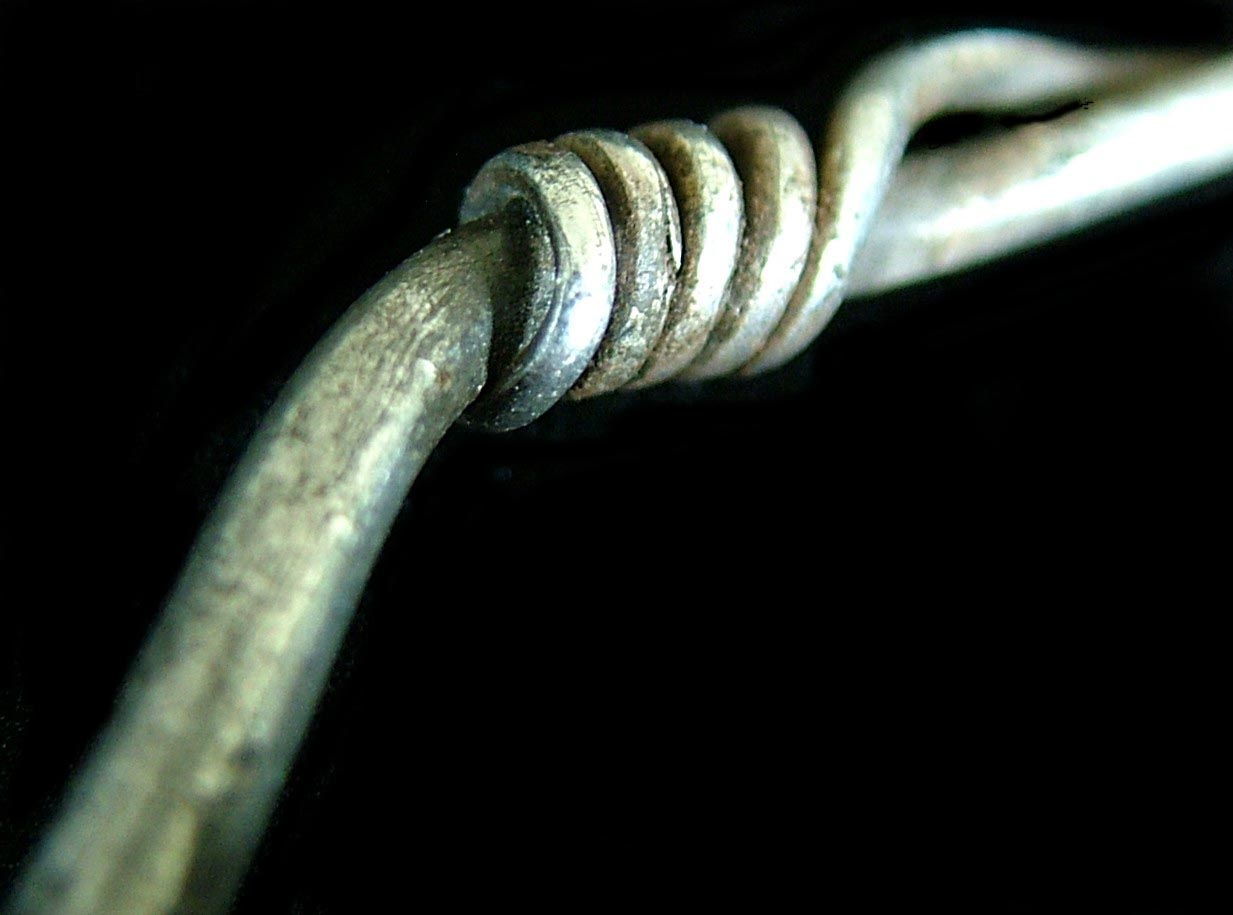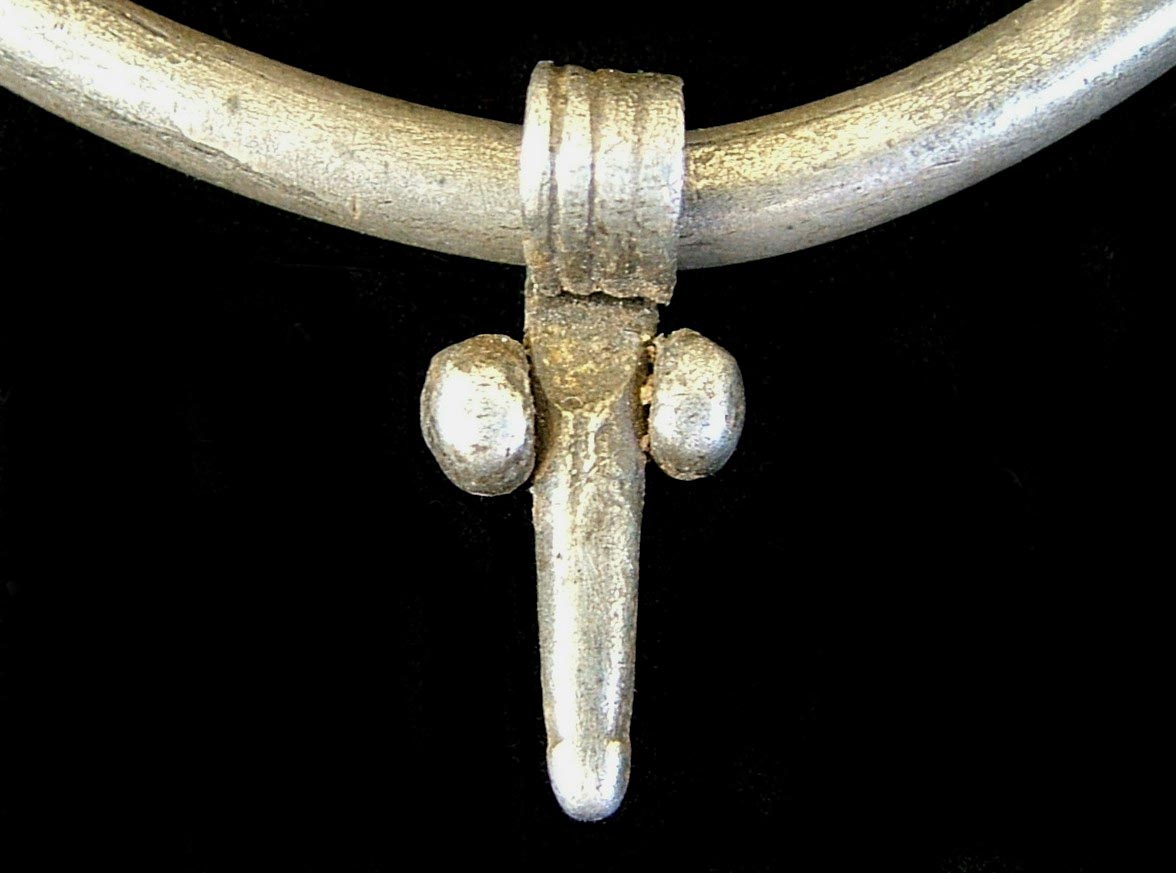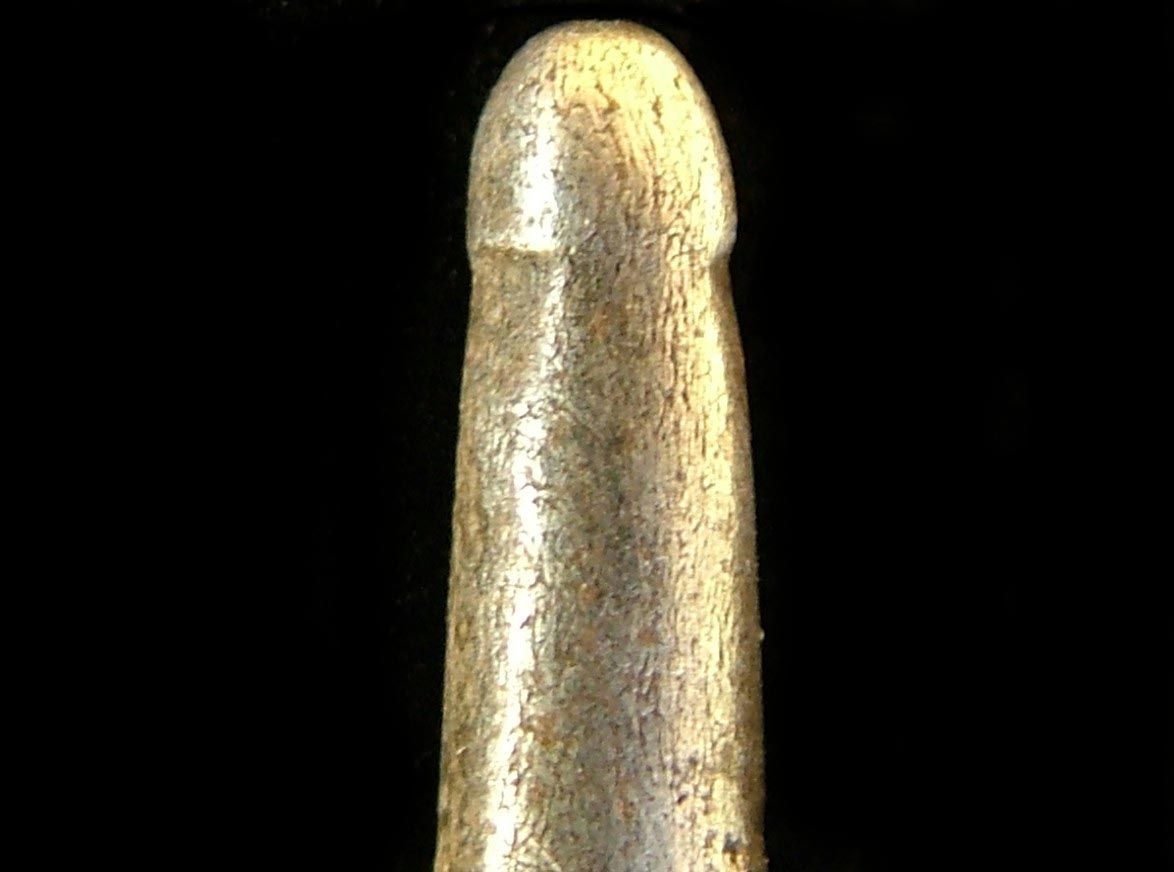 |
|---|
Galli Saka Necklace |
|||||||||
| Galli Saka Necklace |
|||||||||
| This artifact had been purchased due to a speculation that some of it's miniature iconography may be of the Mithraic mystery cult, a cult that was popular with the Roman Army, instead it is in fact of the mystery cult of the goddess Cybele. The piece was purchased from a very reputable British Antiquities Dealer with no further provenance, it will soon be offered at an online auction, the pictures that are posted and this information is to be archived. This is a silver with mixed resins (possibly with some amber) choker necklace with a phallus pendant that appears to have been worn by a Gallus Priest, in some areas the silver is a silver alloy (with lead and mercury). There is information contained in miniature art on this piece that suggests that it may in fact have been worn by one of the higher initiates of the Galli Roman priest college, who were apparently known as the Galli Saka (this translates as Gallic Scythians (or Gaulish Scythians)). As of right now this is the only known verifiable piece of Galli jewelry. The necklace is 31.7 cm in diameter (on the inside of the necklace) and appears to have been permanently intertwined so that the wearer never removed it. The engraving on the resins in front could only have been done after it had been put on. The slight waved curves on each side of the necklace show it had been worn for some time, due to the distinct type of waved curves it does not appear that was made for a statue or as a votive offering, but the possibility of the former cannot be ruled out, it should be noted that in this position the phallus pendent is inverted, the symbolism with this is evident. The miniature art on this piece is done in a style that is of the Eastern Provinces of the Roman Empire. It is of the 2nd to 3rd C. AD. An engraved inscription shows the name "Sablia" (not seen with the pictures provided). A speculation is that this is a feminine variation of the name of the "Sabeans" of Arabia Felix. This hints that some of the resin may be of Frankincense that is from the region, or that the Galli Saka that wore this may have originated from that region. If so then according to current scholarly information, if a feminine name then it must have been a name that was only used in the priesthood, it is thought that in public the Galli only used masculine names. The Galli Priests were members of an effeminate Roman priest college of the Magna Mater (Great Goddess) Cybele. Until the 1st Century AD, Roman citizens were barred from membership in this priest college; it can therefore be assumed that in keeping with tradition, many of the Galli Saka continued to be foreigners. According to descriptions of ancient writers, the initiates castrated themselves during a ceremony known as the Dies Sanguinis (Day of Blood); this was done in imitation of their emasculated Phrygian god Attis. In short Attis's story is as follows: The attractive, effeminate Attis was driven mad by Cybele's sexual jealousy. He committed self castration (with a knife) on her sacred mountain (Mount Ida) under a pine tree, he dies with his life's blood turning into flowers (usually violets), he then turns into a pine tree. Cybele finds him and brings him into a cave, he then descends into the underworld for three days, upon his return he is reborn as Cybele's daughter lover; in essence Attis was reborn as a fatherless goddess worshipping transgendered woman. The Dies Sanguinis ritual took place at the same time that Attis as a decorated pine tree was paraded in the streets to be brought to the temple of Cybele. During this ecstatic ritual the priests danced in a frenzy, the dress of the priests was described as outlandish. It should be mentioned that any descriptions of this cult by the ancient Roman writers Juvenal and Firmicus is not favorable, they very much viewed it as un-Roman and degenerate. What is not mentioned is that according to the information on this necklace that at the very least the higher initiates of the Galli Saka were a disciplined priesthood. Speculations with any Galli sexual preferences are as follows: There are hints that the Galli Saka may have only had sex with each other, or with women, or both of these, or that they may have been a-sexual. There are suggestions that the lower initiates were in fact male temple prostitutes, but that they attended classes and were expected to attain a certain knowledge in order to be elevated, that is, the same as any other lower initiate in a Roman priest's college. The cult of Cybele was brought to Rome during the second Punic War (in 204 BC). This was due to a passage in the Sibylline Books that stated that in order to be victorious over all Rome's invaders, the goddess (a statue of Cybele with a meteorite embedded in its brow) should be brought to Rome from Pessinos in Asia Minor. The statue was procured and then ceremonially brought to the Temple of Victoria; later a temple for Cybele was built. The worship of this goddess was brought to new heights by the Emperor Augustus. During and after the Augustan Era, Cybele and her priests became a major part of the Roman belief system. It has baffled some historians as to why a cult of foreign, goddess worshipping transgendered priests would be given such a status with the Roman State and people. The information on this necklace concerning this mystery cult may explain at least some of it. Later the Rome's mainstream Christians (but not the Gnostics) would go to great lengths to wipe out even the memory of the cult of Cybele; for the most part they were successful. Some of the iconography seen with on this necklace may show why the Christians were so determined to do so. Pictures 3 thru 8 shows engraved inscriptions near the top of the necklace. This is the area that has the inscription Sablia (again this cannot be seen in these pictures), it also on the right side (of the wearer) that has the ring with the resins. This is a style of inscription that has letters that will transform into figures, when moved these will change, it is a type of ancient short-hand. Picture 9 shows a long stick with a male head on top and a whip with a female head on top made of branch bark (most likely from a pine tree). Although it cannot be seen in the pictures the stick has an inscription that is of Mt. Berecyntus. The whip is of Mt. Ida and the goddess Cybele. Picture 10 shows a small figure in a pilus cap coming from under the branch bark whip. The small figure is holding a bowl, just behind the small figures face there is a female face that is somewhat part of the small figure's face, this should represent Attis. Pictures 11 and 12 show various engraved figures. Notice that it picture 12 there is a cross, but in fact it is not a cross, it is a sword with a cruciform hilt, the lighter engravings show flames, so it is a flaming sword. According to other art on Roman artifacts the cruciform hilt in the Roman world is never an actual sword, but rather it is symbolic of the magnetic and possibly something celestial. This flaming sword is significant to the Galli Saka and will be seen again on the arm band area of the necklace. Pictures 13 thru 15 show a deeply engraved letter "G" that is also a "C". This has to do with the the goddess Cybele and the spur of Mt. Ida known as Gargarus. This also has to do with the Trojan War, there are hints that this may also have to do with the goddess Cybele and Roman Army battle award known as the Corona Muralis. |
|||||||||
Necklace Finger Ring
|
|||||||||
| This area of the necklace is referred to as "The Necklace Finger Ring". The reason for this is that it suggests that it is an imitation of an actual initiate's serpent ring that the Galli Priests wore, there are suggestions that these were presented upon a completion of the lower level mysteries. There are suggestions with this that the Galli in fact were named for the Gallus River in Phrygia, and that the actual meaning of the name Gallus is something like a "Water Nymph of Cybele". Pictures 1 thru 4 show scenes on the serpents head. It appears to have something to do with a temple, two figures in a bed and a large figure that may be a temple house with legs and arms. Picture 5 shows the serpent head as male and a female heads as if kissing. Pictures 6 and 7 shows the serpents head as a serpent/bird head with a figure coming from the beak. Pictures 8 thru 23 show that the area with the resin has two wavy lines that suggest the labia. There is a distinct letter "C" for Cybele. the middle in what is the vagina there are different resins that may be frankincense, myrrh, and amber (possibly seen as symbolic for gold metal). It also suggests honey, in fact some of the figures are somewhat bee like and there is one large flower. The top resin figure can be seen as if nursing from Cybele. Pictures 19 and 21 show a phallus as if being presented to Cybele, behind this there is what appears to be a woman and a child. The wavy lines can also be seen as symbolic of a river, the position hints that it is also a mountain torrent of water (a cleansing torrent). The right side can be seen as a crescent moon and an offering dish, this appears to be an aspect of Cybele as a moon, nature, river, and a late winter or spring mountain waterfall goddess, all this suggests a spring mountain baptism. Pictures 24 thru 29 show figures in a row, these will change when moved. Pictures 26 and 27 show one figure holding a small sphere, it may be made of amber. Picture 29 is most significant as it shows what appear to be a group of initiates in a line, one of the figures in front is holding up a tablet with figures on it, this may suggest some type of diploma. |
|||||||||
Necklace Armband
|
|||||||||
| This area of the necklace is referred to as "The Necklace Armband". The reason for this is that it suggests that it is an imitation of an actual initiate's serpent armband that the Galli Priests wore on the left upper arm, there are suggestions that these were presented upon a completion of a higher level mystery or mysteries. Pictures 1 thru 5 show the serpent's head as a male head that when moved will change into a female head. Pictures 6 and 7 show a figure that appears to be male and female, there is a wavy line down the middle as if the figure is split. Pictures 8 thru 12 show the figure now has a flaming cruciform sword that is splitting the figure down the middle, the sword is striking the figure's genitals, the lower part of the figure is on a large triangle, this is also where the sword is striking. This appears very similar to a sacred Scythian sword that symbolized their War god, it was place on top of a platform in a bundle of sticks. The Scythians did in fact worship the goddess Cybele and they did have transgendered eunuchs from the upper levels of their society. Pictures 13 to 15 show various figures on the armband's coils, many of these appear as if they are the reflections of a mirror, they are of a Steppe people, most distinct is an engraved figure on the first coil, it is on top of a head in a Phrygian hat (Attis), this may be a Scythian priest of Cybele. The head in the Phrygian hat is made of a silver but it is overlaid with a tar pitch, most likely coming from the sap of a pine tree. Pictures 16 thru 21 show that there are many small figures that make up larger figures, it also shows that the engraved figure on top of Attis's head is the hilt of a knife, this knife can also be seen as a dagger. Pictures 22 thru 24 show two figures as if embracing, the figure on the left is a nude bodacious looking female with her hair up (most likely Cybele in some form), to the right is a male or female figure. Picture 25 shows a prone figure as if peering into a crevice. Picture 26 shows a bovine head. There is every indication that the Galli armband was of an initiation that was symbolic of a celestial fire, a splitting as in a type of baptism by fire. It is evident that it was associated with the Scythians, not the Phrygians. |
|||||||||
|
| |
Necklace Pendant A |
This is the phallus pendent. It is made with resins and tinted metal, some of the tinting is in gold gilding. Picture 1 shows the pendant that way it was worn on this necklace. The top part shows a Asiatic woman holding a dragon serpant. The serpent is also the letter "C" that can also be seen as the letter "G". The serpent's head is also part of a large letter "S", there are also the smaller letters that can make this read as SACA or as PACA, This should be Roman for the Greek word Saka (Scythian) and perhaps the "PACA" is a word for contract, hence it may read something like "The Scythian Pact". Below this is a Scythian (identified by his long hair, headband, and beard) with a figure that has a rope around his neck, the rope is also a device that is being used to remove the Scythian's testicle. The Scythian's face can also be seen as two small figures, notice that only one testicle is shown, this hints that this may have been the actual ritual, not the castration of both testicles, or a complete removal of the genitals that is speculated by some. Picture 5 shows a side view. Picture's 6 thru 9 shows this area upside down. It has various figures, the most important is a tall figure with a long whip, the whip is over a man's face, this part of the whip makes for a large letter "C", once again this should be another aspect of the goddess Cybele as a flagellator. Picture 10 shows the front of the phallus pendant. although on this necklace this it was worn inverted. Pictures 11 thru 13 shows the loop as three figures, under this is a large letter "C". Picture 14 shows that the phallus has a lightly engraved streaking face, it hints of a meteor strike. Pictures 15 and 16 show something like a tee pee shaped yurt, that is also a bit like a letter "A", it may alss suggest a pine tree. The streaking head above this is more intense, it now looks much more like a meteor striking Under this is a lion and a lioness head (once again these have many smaller figures inside of it), the lion and lioness are the chariot bearing animals of Cybele, their noses are also the letters "C" and "S", possibly for Cybele and Saka. Picture 17 shows what now definitely looks like a meteor strike. Picture 18 shows a horned bovine with a disc (with a cross in it) on top of the horn to the right. The bull is another sacred animal of Cybele, it is the animal of the sacrificial blood rite of Cybele's tauribolium.
|
| |
Necklace Pendant B |
Some of the pictures with this picture group are still being edited as well as the format of this page, so for now the information with these is not as detailed. The pictures show that the phallus has various figures, perhaps something to do with a creator god. Most importantly other pictures show the phallus is also a meteor, the head has various faces and or facial expressions, there are also two faces (most likely twins) that appear as if on a mirror. The pictures of the area near the testicles may not be in sequence yet, but it shows that one testicle was cut off, then the initiate was placed in a cave like environment (in order to make a journey to the underworld), and then returned as someone new. The iconography on the necklace and pendant appears to be symbolic of the many countless myths and stories about mythical and legendary figures who begin with a pleasure seeking adventures, then find that it turns into a painful ordeal that is necessary in order to give up the old as to create the new, but untypicaly in this version it is the transition of a male to a female identity. There are various suggestions that at least some of this may have originated from the fire worship and dualism of the more ancient Indo-Iranians. Although all this was counter to the Roman mentality, it was nevertheless important to the Roman State as well as the people. It appears that the cult viewed themselves as representatives of a primeval protection for the continuance of Rome, most likely little of this was understood by most of the Roman citizenry. Copyright 2008 David Xavier Kenney | ||

